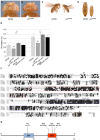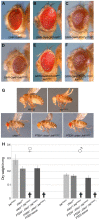The Drosophila SH2B family adaptor Lnk acts in parallel to chico in the insulin signaling pathway
- PMID: 19680438
- PMCID: PMC2716533
- DOI: 10.1371/journal.pgen.1000596
The Drosophila SH2B family adaptor Lnk acts in parallel to chico in the insulin signaling pathway
Abstract
Insulin/insulin-like growth factor signaling (IIS) plays a pivotal role in the regulation of growth at the cellular and the organismal level during animal development. Flies with impaired IIS are developmentally delayed and small due to fewer and smaller cells. In the search for new growth-promoting genes, we identified mutations in the gene encoding Lnk, the single fly member of the SH2B family of adaptor molecules. Flies lacking lnk function are viable but severely reduced in size. Furthermore, lnk mutants display phenotypes reminiscent of reduced IIS, such as developmental delay, female sterility, and accumulation of lipids. Genetic epistasis analysis places lnk downstream of the insulin receptor (InR) and upstream of phosphoinositide 3-kinase (PI3K) in the IIS cascade, at the same level as chico (encoding the single fly insulin receptor substrate [IRS] homolog). Both chico and lnk mutant larvae display a similar reduction in IIS activity as judged by the localization of a PIP(3) reporter and the phosphorylation of protein kinase B (PKB). Furthermore, chico; lnk double mutants are synthetically lethal, suggesting that Chico and Lnk fulfill independent but partially redundant functions in the activation of PI3K upon InR stimulation.
Conflict of interest statement
The authors have declared that no competing interests exist.
Figures





Similar articles
-
Regulation of lifespan, metabolism, and stress responses by the Drosophila SH2B protein, Lnk.PLoS Genet. 2010 Mar 19;6(3):e1000881. doi: 10.1371/journal.pgen.1000881. PLoS Genet. 2010. PMID: 20333234 Free PMC article.
-
The Lnk/SH2B adaptor provides a fail-safe mechanism to establish the Insulin receptor-Chico interaction.Cell Commun Signal. 2013 Apr 16;11(1):26. doi: 10.1186/1478-811X-11-26. Cell Commun Signal. 2013. PMID: 23590848 Free PMC article.
-
Drosophila Longevity Assurance Conferred by Reduced Insulin Receptor Substrate Chico Partially Requires d4eBP.PLoS One. 2015 Aug 7;10(8):e0134415. doi: 10.1371/journal.pone.0134415. eCollection 2015. PLoS One. 2015. PMID: 26252766 Free PMC article.
-
The role of insulin signalling in the endocrine stress response in Drosophila melanogaster: A mini-review.Gen Comp Endocrinol. 2018 Mar 1;258:134-139. doi: 10.1016/j.ygcen.2017.05.019. Epub 2017 May 26. Gen Comp Endocrinol. 2018. PMID: 28554733 Review.
-
The adaptor Lnk (SH2B3): an emerging regulator in vascular cells and a link between immune and inflammatory signaling.Biochem Pharmacol. 2011 Nov 15;82(10):1391-402. doi: 10.1016/j.bcp.2011.06.023. Epub 2011 Jun 24. Biochem Pharmacol. 2011. PMID: 21723852 Review.
Cited by
-
Centrosome misorientation mediates slowing of the cell cycle under limited nutrient conditions in Drosophila male germline stem cells.Mol Biol Cell. 2012 Apr;23(8):1524-32. doi: 10.1091/mbc.E11-12-0999. Epub 2012 Feb 22. Mol Biol Cell. 2012. PMID: 22357619 Free PMC article.
-
The Drosophila PGC-1 homologue Spargel coordinates mitochondrial activity to insulin signalling.EMBO J. 2010 Jan 6;29(1):171-83. doi: 10.1038/emboj.2009.330. Epub 2009 Nov 12. EMBO J. 2010. PMID: 19910925 Free PMC article.
-
Divergent and convergent roles for insulin-like peptides in the worm, fly and mammalian nervous systems.Invert Neurosci. 2014 Sep;14(2):71-8. doi: 10.1007/s10158-013-0166-9. Epub 2014 Jan 7. Invert Neurosci. 2014. PMID: 24395463 Free PMC article. Review.
-
Expression and characterization of Drosophila signal peptide peptidase-like (sppL), a gene that encodes an intramembrane protease.PLoS One. 2012;7(3):e33827. doi: 10.1371/journal.pone.0033827. Epub 2012 Mar 16. PLoS One. 2012. PMID: 22439002 Free PMC article.
-
Effect of Insulin Receptor on Juvenile Hormone Signal and Fecundity in Spodoptera litura (F.).Insects. 2022 Aug 4;13(8):701. doi: 10.3390/insects13080701. Insects. 2022. PMID: 36005325 Free PMC article.
References
-
- Rulifson EJ, Kim SK, Nusse R. Ablation of insulin-producing neurons in flies: growth and diabetic phenotypes. Science. 2002;296:1118–1120. - PubMed
-
- Garofalo RS. Genetic analysis of insulin signaling in Drosophila. Trends Endocrinol Metab. 2002;13:156–162. - PubMed
-
- Chen C, Jack J, Garofalo RS. The Drosophila insulin receptor is required for normal growth. Endocrinology. 1996;137:846–856. - PubMed
-
- Ikeya T, Galic M, Belawat P, Nairz K, Hafen E. Nutrient-dependent expression of insulin-like peptides from neuroendocrine cells in the CNS contributes to growth regulation in Drosophila. Curr Biol. 2002;12:1293–1300. - PubMed
Publication types
MeSH terms
Substances
LinkOut - more resources
Full Text Sources
Medical
Molecular Biology Databases
Miscellaneous

